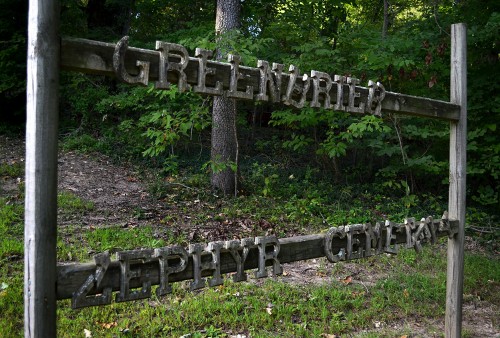 The Civil War that was fought in our region wasn’t one of epic battles involving tens of thousands of massed troops. It was more like guerrilla warfare, bushwhackings and massacres, labels that differed depending on which side you were on.
The Civil War that was fought in our region wasn’t one of epic battles involving tens of thousands of massed troops. It was more like guerrilla warfare, bushwhackings and massacres, labels that differed depending on which side you were on.
One of our rambles took us to the Greenbrier/Zephyr Cemetery in southern Bollinger County. It’s not particularly easy to find, and the road leading to it isn’t all that easy to hit. You pretty much have to drive past it, turn around the first opportunity and head back in order to get the right angle. It’s one-way in, so be prepared to back up.
Mass grave for Confederate dead
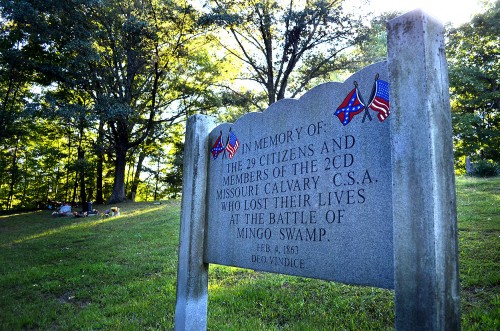 Mother and I went looking for it because I had read about the Battle of Mingo Swamp and the mass grave in the cemetery. Here’s a version of what happened from Cletis R. Ellinghouse’s book, Mingo: Southeast Missouri’s Ancient Swamp and the Countryside Surrounding It:
Mother and I went looking for it because I had read about the Battle of Mingo Swamp and the mass grave in the cemetery. Here’s a version of what happened from Cletis R. Ellinghouse’s book, Mingo: Southeast Missouri’s Ancient Swamp and the Countryside Surrounding It:
The Battle of Mingo Swamp was fought February 4, 1863, on the south Bollinger County plantation of Simeon “Slim” Cato, a 58-year-old South Carolina native who died in the bloodbath with 28 others, all Confederate soldiers. It was the bloodiest single incident in the war in Southeast Missouri. Among the other slain were Confederate Capt. Daniel McGee and his first sergeant James A. Logan, who at the time resided at what later became Puxico. McGee was Cato’s nephew.
Confederates caught unawares
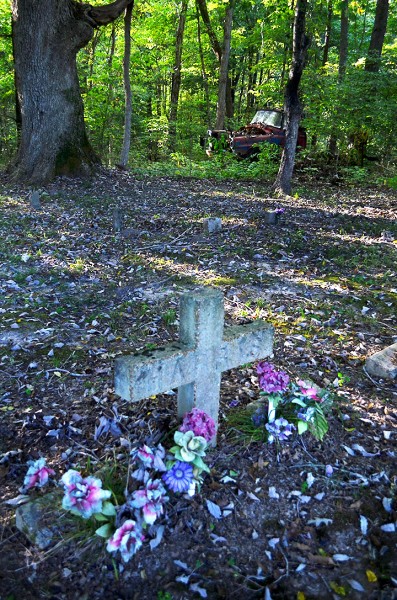 The Confederates, surrounded by Union soldiers, were completely unaware of what was about to happen to them. They were not within reach of their weapons when soldiers from the Twelfth Missouri State Militia Cavalry pounced on them in a vicious assault that left all of them dead or mortally wounded. “All but four too seriously wounded to be removed,” according to an account published in a St. Louis newspaper, which referred to McGee as “the notorious guerrilla chief.” In fact, all of them were killed outright or died of wounds without a single casualty on the Union side, which has prompted some to call the operation “a massacre.”
The Confederates, surrounded by Union soldiers, were completely unaware of what was about to happen to them. They were not within reach of their weapons when soldiers from the Twelfth Missouri State Militia Cavalry pounced on them in a vicious assault that left all of them dead or mortally wounded. “All but four too seriously wounded to be removed,” according to an account published in a St. Louis newspaper, which referred to McGee as “the notorious guerrilla chief.” In fact, all of them were killed outright or died of wounds without a single casualty on the Union side, which has prompted some to call the operation “a massacre.”
The remains of the Confederates, routinely called outlaws and guerrillas by Union officers, were carried by wagons and buried by kinsmen and neighbors at what is known today as the Greenbrier/Zephyr Cemetery, a few miles from where they were slain. Their mass grave was discovered many years ago. Uniforms, coats and button were found along with the remains of several bodies.
Other references
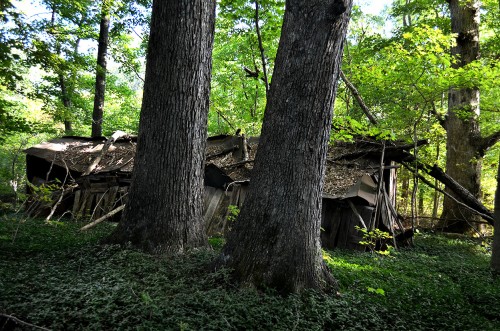 Depending on whose account you read, Sam Hildebrand was just a guy who wanted to be left alone and stay out of “the rich man’s war being fought by poor men,” or he was “The Big River Bushwhacker, Southeast Missouri’s notorious outlaw.” Others put him in the camp of those men who used the war as an excuse to settle personal affronts. His exploits rival any movie you’ve seen.
Depending on whose account you read, Sam Hildebrand was just a guy who wanted to be left alone and stay out of “the rich man’s war being fought by poor men,” or he was “The Big River Bushwhacker, Southeast Missouri’s notorious outlaw.” Others put him in the camp of those men who used the war as an excuse to settle personal affronts. His exploits rival any movie you’ve seen.
Most of us grew up hearing about Forts A, B C and D, but I was never taught about the major battle that was fought in the town. This is an account worth reading.
As always, you can click on the photos to make them larger.
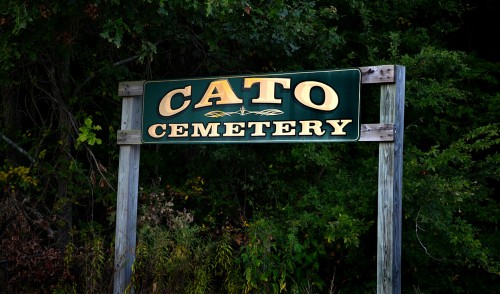 While wandering and wondering around Bollinger County looking for the Bootheel’s once wild and wooly Dark Cypress and the cemetery containing the mass grave of Confederates killed in the Battle of Mingo Swamp, Mother, my cemetery-spotter extraordinaire, saw this sign for Cato Cemetery.
While wandering and wondering around Bollinger County looking for the Bootheel’s once wild and wooly Dark Cypress and the cemetery containing the mass grave of Confederates killed in the Battle of Mingo Swamp, Mother, my cemetery-spotter extraordinaire, saw this sign for Cato Cemetery.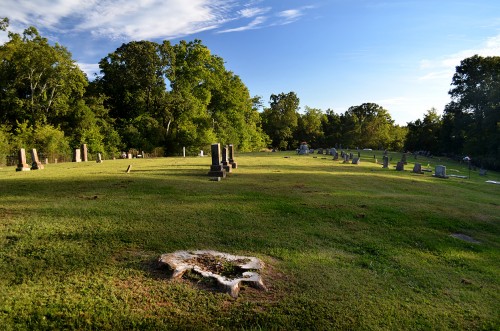 I don’t know how far this is from the battlefield, but it’s a quiet place today. Large stumps show that it must have been dotted with big trees that have fallen to disease and old age over the years. (Click on the photos to make them larger.)
I don’t know how far this is from the battlefield, but it’s a quiet place today. Large stumps show that it must have been dotted with big trees that have fallen to disease and old age over the years. (Click on the photos to make them larger.)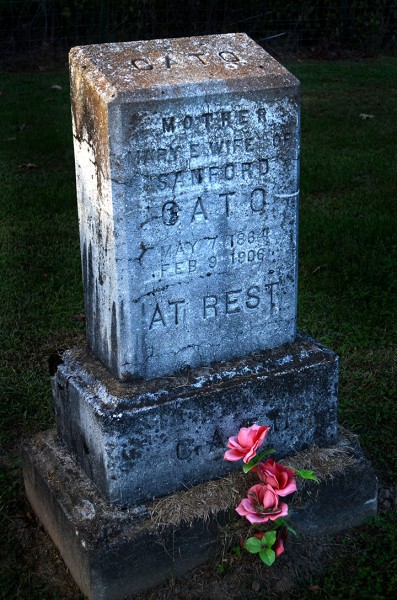 There are lots of stones marking the final resting places of Catos. I didn’t find one for “Slim.” I don’t know if his body was ever moved from the mass grave.
There are lots of stones marking the final resting places of Catos. I didn’t find one for “Slim.” I don’t know if his body was ever moved from the mass grave.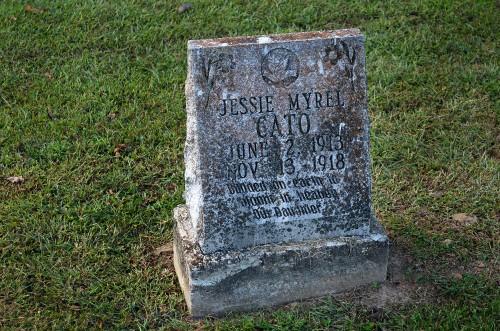 I couldn’t find much history of the cemetery, but here are some partial listings of those interred there.
I couldn’t find much history of the cemetery, but here are some partial listings of those interred there.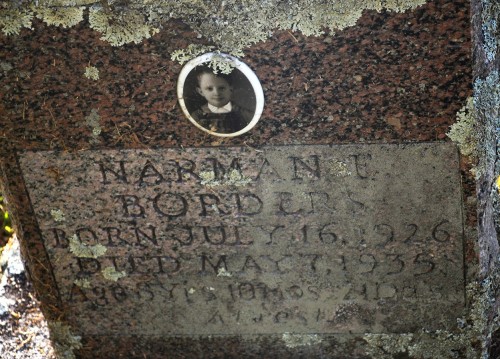 Narman E. Borders, who is “at rest, ” died at only “8 years, 10 mos and 21ds.”
Narman E. Borders, who is “at rest, ” died at only “8 years, 10 mos and 21ds.”



